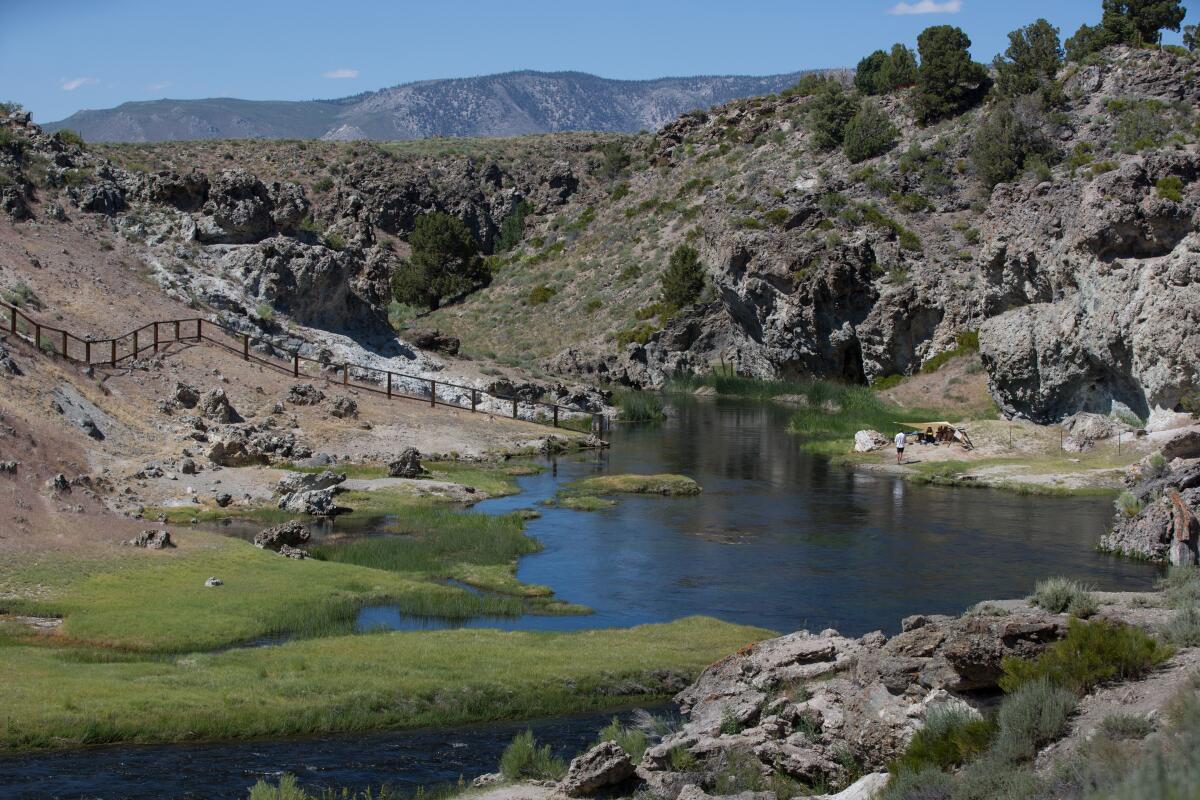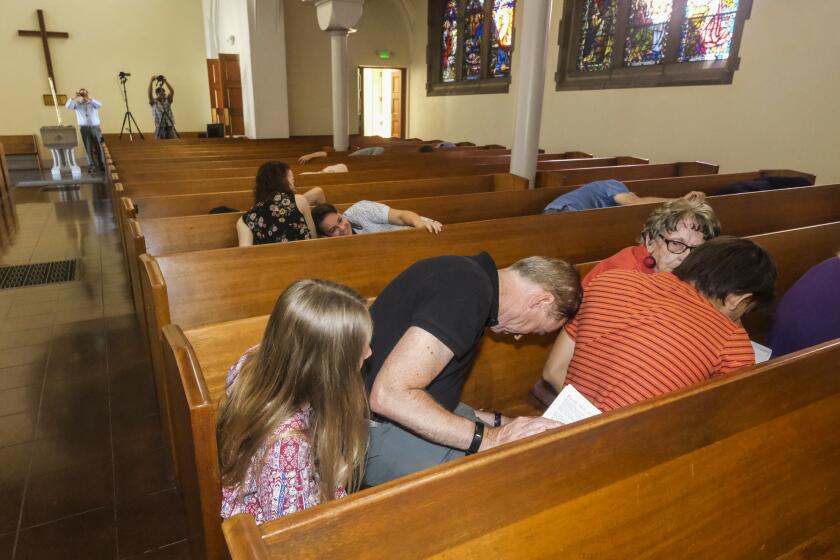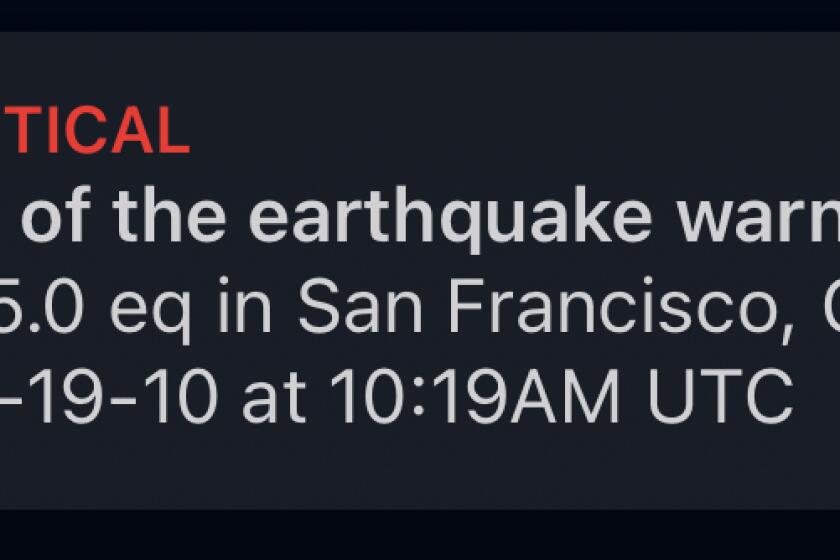One of California’s riskiest volcanoes has been seeing more earthquakes. Is an eruption coming?

- Share via
One of California’s riskiest volcanoes has for decades been undergoing geological changes and seismic activity, which are sometimes a precursor to an eruption, but — thankfully — no supervolcanic eruptions are expected.
That’s according to Caltech researchers who have been studying the Long Valley Caldera, which includes the Mammoth Lakes area in Mono County. The caldera was classified in 2018 by the U.S. Geological Survey as one of three volcanoes in the state — along with 15 elsewhere in the U.S. — considered a “very high threat,” the highest-risk category defined by the agency.
The two other volcanoes in California with that classification are Mt. Shasta in Siskiyou County and the Lassen Volcanic Center, which includes Lassen Peak in Shasta County. The threat assessment is not a list of which volcanoes are most likely to erupt or a ranking of those that are most active; rather, it’s defined as a combination of a volcano’s potential threat and the number of people and properties exposed to it.
The scientists’ findings were published last week in the journal Science Advances.
Churches, temples, mosques and other faith-based institutions could be key in helping communities prepare for natural disasters, Lucy Jones says.
The Long Valley Caldera is a broad depression of land east of the Sierra Nevada. It’s roughly 40 miles east of Yosemite Valley, 200 miles east of San Francisco and 250 miles north of downtown Los Angeles. A caldera is formed when magma erupts or is otherwise taken out from beneath the ground.
The Long Valley Caldera was formed by a super-eruption about 760,000 years ago that blasted 140 cubic miles of magma, covering much of east-central California in hot ash that was blown as far away as present-day Nebraska.
Scientists have long scrutinized the Long Valley Caldera, where there have been noticeable increases in earthquakes and ground fluctuations that began four decades ago. Notably, there were four magnitude 6 earthquakes in the Long Valley area in May 1980.
Generally speaking, changes in the shape of the ground and earthquake activity are commonly observed before eruptions — but those things do not necessarily mean an eruption will arrive soon.
Researchers have long thought the risk of a supervolcanic eruption in the Long Valley Caldera in our lifetime is extremely low, given that overall, the magma underneath the area is clearly cooling — essentially continuing to calm down.
Still, the recent geological phenomena posed an important question for scientists: What does the increased seismic activity and deformation of the ground mean? Is it a precursor to something alarming?
A massive earthquake rattles a town, triggering fiery eruptions in nearby volcanoes.
Fundamentally, scientists sought answers to two questions, said Emily Montgomery-Brown, a USGS research geophysicist who was not involved in the Caltech study. Was there enough magma in connected segments of the underground reservoir to combine and erupt? Or was there a more reassuring explanation for the earthquakes and ground movement, specifically that as the cooling magma crystallized and solidified, were other non-magma fluids now coming to the surface and triggering quakes?
The Caltech scientists concluded that the latter explanation appears to be the answer. That’s based on high-resolution underground images re-created with the use of several dozen seismometers, earthquake measurements and a machine-learning algorithm, according to the university.
“We don’t think the region is gearing up for another supervolcanic eruption, but the cooling process may release enough gas and liquid to cause earthquakes and small eruptions,” Zhongwen Zhan, a Caltech professor of geophysics and a study co-author, said in a statement.
Some Californians received a test of the earthquake early-warning system seven hours before the appointed time, waking them at 3:19 a.m. Thursday.
There are some scientists who suspect the Long Valley Caldera as a volcano is moribund — essentially dead — and the increased seismic activity, when it happens, is being generated by fluids that are not magma, but are still hot and moving to the surface as the magma cools and solidifies. Others, however, argue the Long Valley Caldera is active.
Montgomery-Brown, an expert on the Long Valley Caldera who is now with the USGS’ Cascades Volcano Observatory, said the most recent episode of increased earthquake activity in the area began in 2011 and was accompanied by a ground deformation in which the land started to rise. That activity has tapered off, and since 2020, a quiet phase has resumed.
But a magmatic eruption is still something to consider, she said. While the Long Valley Caldera itself is old and its magma is cooling and crystallizing, “there are extremely young lava flows” along the nearby Mono-Inyo Craters chain.
“And so even if the Long Valley magma reservoir is moribund, there are other pockets of magma in the area,” Montgomery-Brown said.
And it’s important to understand the area still poses a significant threat and remains capable of powerful earthquake swarms.
The guide to earthquake readiness and resilience that you’ll actually use.
California’s other volcanoes also pose risks. And eruptions could have lasting repercussions that affect the entire state.
Volcanic ash, when wet, is conductive and could disrupt high-voltage lines that supply electricity to millions of California homes. It could interfere with travel on Interstate 5, the main route between California and Oregon, masking windshields and making roads slippery, even impassable.
Ash could disrupt hundreds of daily flights in Northern California or the Mammoth Mountain area or bring down jetliners. And it could contaminate water supplies to much of the state (California’s largest reservoirs are close to the Shasta and Lassen volcanoes).
Mt. Shasta, California’s largest volcano, had many eruptions in prehistoric times but has remained quiet in the modern era. And like the Long Valley Caldera, the magma beneath Lassen Volcanic Center is showing clear signs of cooling and contracting, Montgomery-Brown said.
California’s last major destructive volcanic eruption came more than a century ago. Lassen Peak underwent a series of eruptions between 1914 and 1917. One explosive eruption in 1915 obliterated a forest and created a gigantic mushroom cloud 30,000 feet high that could be seen as far as away as Eureka and Sacramento and blew volcanic ash 280 miles out, reaching Elko, Nev.
More to Read
Sign up for Essential California
The most important California stories and recommendations in your inbox every morning.
You may occasionally receive promotional content from the Los Angeles Times.














